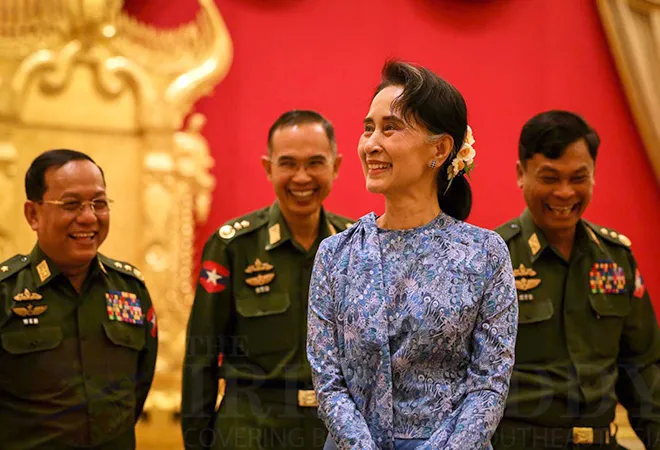As State Counsellor and Foreign Minister Daw Aung San Suu Kyi wraps-up her five-day official visit to China, some media reports have framed the visit within Myanmar’s wider foreign policy challenge of balancing Beijing and Washington. However, the move seems to indicate Naypyitaw’s evolving foreign policy priorities that are driven more by the need to stabilise the country’s troubled border regions and to address the nation’s economic development as the country plays catch up. For this, Naypyitaw is turning to its immediate neighbours.
Myanmar’s new leadership under the National League for Democracy (NLD) recognises that foreign policy begins at the border and, more importantly, borders are where the linkages between internal and external issues are most profound with direct impact on a country’s security and well-being. There is no better example of these cross-border linkages — from ethno-cultural, border trade, smuggling, gun running — to illegal logging, that exhibit more vividly than along Myanmar’s borders with its neighbours. The Southeast Asian nation’s border regions have long been a source of economic growth and security challenge.
At a recent meeting on Myanmar’s ethnic peace process in Naypyitaw, Suu Kyi emphasised the intricate linkage between peace and development. Suu Kyi reiterated the point during her China trip. Suu Kyi stated: “If you ask me what my most important aim is for my country, that is to achieve peace and unity among the different peoples of our union.. Without peace, there can be no sustained development.” This complex development-security nexus manifests most forcefully in the border regions, and the recognition of this predicament evidently is prompting the NLD leadership to direct its diplomatic energy towards the country’s neighbourhood.
Suu Kyi’s China trip has been described as boosting “strategic cooperation” between the two countries. Bilateral relationship of two countries witnessed a setback under the previous Thein Sien administration. Since Suu Kyi’s NLD won the historic November elections and after the party assumed office in March this year, Naypyitaw and Beijing have been trying to mend their ties.
Myanmar shares long land and maritime boundaries with Bangladesh and India to the west — sharing the Bay of Bengal; Laos and Thailand to the south-east; and China to the north. In May this year, Suu Kyi accompanied Myanmar’s President Htin Kyaw’s first foreign trip to neighbouring Laos. During the visit the two sides discussed issues relating to peace and stability in their shared border regions, cross-border trade, and connectivity among other issues.
In June, State Counsellor Suu Kyi visited another neighbour, Thailand during which the two countries further strengthened bilateral ties. Importantly, Myanmar and Thailand successfully addressed the long-standing issue involving the protection of rights of millions of Burmese migrant workers in Thailand. The two sides also set up a three-year development cooperation framework (2016-18) for border areas and discussed issues related to connectivity and economic cooperation.
With her visit to China now, Suu Kyi has travelled to three of the five immediate neighbours of Myanmar. President Kyaw is expected to visit India sometime soon. According to media reports, Suu Kyi may visit Bangladesh later this year. President Kyaw’s India visit and if Suu Kyi’s Dhaka trip happens, the Myanmar new leadership will roundup all the five neighbours in the first year since assuming office.
< style="color: #163449;">Why China now?
Beyond Myanmar’s evolving neighbourhood diplomacy, the growing power play between China and the United States in the region may not be completely absent in Suu Kyi’s decision to visit Beijing before a planned trip to Washington next month at the invitation of US President Barack Obama. But more than geopolitical calculations, Myanmar’s key objectives through this visit was to win China’s support to resolve some of the country’s long-standing issues — border stability and economic development.
The NLD administration has called for the “21st Century Panglong” peace conference on < class="aBn" tabindex="0" data-term="goog_204276636">< class="aQJ">August 31 with the aim to find a resolution to the six-decade old ethnic conflicts. Myanmar government’s key and urgent concern is to get China on its side to achieve peace in the border regions as it prepares to hold the historic peace conference. Most of the ethnic armed organisations (EAOs) that have not yet signed ceasefire are based along China-Myanmar border. In fact, China has long exercised strong influence on some of the EAOs such as the Kokang (who are ethnic Chinese), the Wa, and the Kachin that operate along China-Myanmar border regions.
Myanmar’s EAOs in the border regions have been a source of tension between the two countries. Suu Kyi now wants to convert this into an area of cooperation. From Myanmar’s perspective, the Chinese leadership’s reaffirmation to “continue to play a constructive role” to promote Myanmar’s peace process and work with the NLD administration to “safeguard peace and stability” in their shared border areas” is an important diplomatic success of the visit. How this will translate on the ground remains to be seen.
As the NLD government tries to re-set ties with its northern neighbour in the hope that it will deepen economic ties between the two countries, major economic issues had emerged to adversely affect the forward movement of their economic ties. The fate of Chinese-funded USD 3.6 billion Myitsone dam project that was suspended in 2011 by the previous administration owing to widespread protests is one such instance. The NLD administration recognises that China remains Myanmar’s top trading partner and a major investor. That Beijing and Naypyitaw have found ways to resolve the dam issue will further open up new areas for cooperation in Myanmar’s economic development — a crucial task of the NLD government.
Sustaining the focus on the neighbourhood is important not only for the well-being of Myanmar, but also the wider region. This will complement with India’s “Neighbourhood First” policy and China’s “Good Neighbourliness” policy. As Myanmar’s NLD administration evolves a new neighbourhood approach, it recognises the importance of a balanced engagement with all the neighbours because that is in everyone’s interest, more so for Myanmar’s own interest. No one should feel left out; after all, neighbours will remain neighbours.
This commentary originally appeared in Global New Light of Myanmar
The views expressed above belong to the author(s). ORF research and analyses now available on Telegram! Click here to access our curated content — blogs, longforms and interviews.




 PREV
PREV


